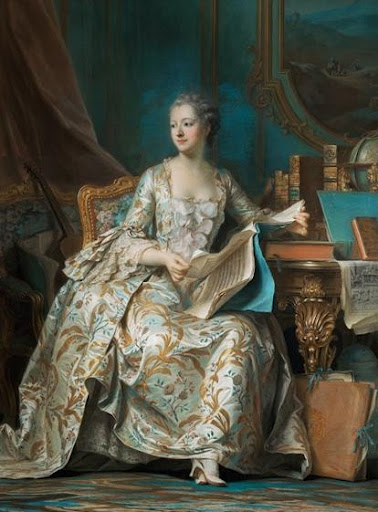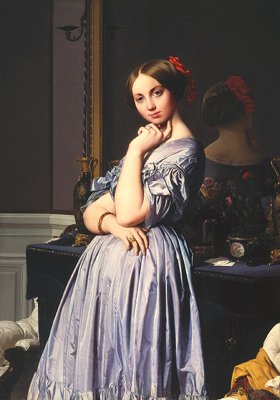Exactly how many pieces of art are in the Louvre is not clear. At the most extreme is the assertion that there are 300,000 paintings and a minimum of 5,000 and the total pieces of art ranging from 35,000 to the previously noted 300,000. In any event, there is no greater collection of paintings of women, essentially Frenchwomen, in the world, especially by Frenchmen. This is what lends the museum more color, grace and impact making it Europe’s and possibly the world’s greatest museum. Clearly, this is a gendered gaze since museums have traditionally bypassed and short-shifted the work of women, consigning it to the category of “crafts” and keeping fine art as a male preserve.

---1755 Marquise de Pompadour pastel by Maurice-Quentin de la Tour (Louvre) Previous Next List The Marquise de Pompadour is portrayed reading sheet music while wearing an opulent dress in this well-known 1755 de Latour work.--- Read More:http://www.gogmsite.net/grand-ladies-of-the-eightee/subalbum-jeanne-antionette-/1755-marquise-de-pompadour-.html
The art world’s long history of chauvinism, of which France was an integral piece, seems to reinforce the notion that art has always been ideological, always in the service of narrow minded nationalism by a laying of claim to the Greco-Roman tradition and transforming it into commodity based bourgeois values. Still, within the context of the times, there were always exceptions, art that partly emancipated itself from the jaws of the taste makers, avoiding the high kitsch that defined Salon art and continues to be filtered down today through outright hacks like Damien Hirst and that ilk, reproducing as best they can the same equally hack and generic philosophies of a Bertrand Russell or Sartre.

---Embodying the freedom and curiosity of the French Enlightenment, Jean-Honoré Fragonard (1732–1806) developed an exuberant and fluid manner as a painter, draftsman, and printmaker. Prolific and inventive, he abandoned early on the conventional career path dictated by the hierarchical structure of the Royal Academy, working largely for private patrons. His work constitutes a further elaboration of the Rococo idiom established by Antoine Watteau and François Boucher, a manner perfectly suited to his subjects, which favored the playful, the erotic, and the joys of domesticity.--- Read More:http://www.metmuseum.org/toah/hd/frag/hd_frag.htm
So, though the Louvre’s art of women by men is limited in comprehension and plagued by a level of disavowal. But, for its time, the better work flowed over the dikes erected by religious reactionism, repression as piety, militarist thinking, apologist art critics, and bleached out intellectuals shilling for whoever would drop their pants for them; all in all, a necessary washing away of discredited social forms dying a slow death from asphyxiation.Despite their deep flaws, noticeably racism and misogyny, in that act of creation, a Degas summoned up psychological insight, a Renoir exposed a light in sheer atmosphere, and a Fragonard represented a heretofore unseen playful exuberance.

---Ingres worked strictly on a business proposition, portrait drawings by the piece, less for faces, more for full length. He did find time to mix patrons with friends—artists and musicians like himself, a passionate violinist. Still, every labor of love knew its value. For all the elegance of a dying age, Ingres documents a feudal class in exile subject to the laws of a growing marketplace. Call it a franc view of sex. Ingres worked slowly. If the Vicomtesse d'Haussonville has an arm growing out of her stomach, it was not for lack of trying—or want of attention to reality. He knew that such apparent mistakes create that modern notion, a painter's style. Studies note folds, rings, rarely backgrounds. Perhaps other painters sketched the rare landscape. Did the jewelry signal his fascination with hands and decoration, a fascination he passed on to his pupils—or excuses to obscure his handling of anatomy, as the Met suggests? Either way, like the unusual arm, it signals Ingres's ability to highlight or obscure detail at will, so as to create a work's intense rhythms. Either way, too, the new-found sensuality of his work thrills me, and it persisted well into his seventies. --- Read More:http://www.haberarts.com/ingres.htm
ADDENDUM:
The following quote seems a bit provocative, even feminist demagoguery. And also not true. However, the implication that fine art is a male patriarchy repository of values, often coated in layers of misogyny masquerading as liberty and freedom is a valid one:
The radical vision of curator Camille Morineau is better understood when you consider that the Louvre, the most visited museum in the world and home to 35000 artworks, does not own a piece by a female artist. In London, just 12 per cent of the Tate Modern’s collection is by female artists, and of the National Gallery’s 2300 artworks, four paintings are by two female artists.* In an interview with The Guardian – where I found these shocking statistics – Morineau explains that 40 per cent of the Pompidou Centre’s works by female artists were acquired in the last four years. Now, the museum holds 500 pieces by women artists. Read More:http://thedawnchorus.wordpress.com/2010/01/19/ellescentrepompidou-women-in-modern-art/

---Seurat was a cultivated person, widely read and with an excellent knowledge of the art of the past. His studies in the Musée du Louvre, Paris, included examining the culture of ancient Egypt, and classical Greek and Roman sculpture. Model in profile, for example, reworks the well-known Greco-Roman bronze, The thorn-puller or Spinario. Seurat knew the sixteenth-century copy held in the Louvre. Here the model is preparing for work, or has finished posing, as she doffs or draws on her green stockings.--- Read More:http://nga.gov.au/Exhibition/MASTERPIECESfromPARIS/Default.cfm?IRN=191255&BioArtistIRN=16097&MnuID=3&GalID=2&ViewID=2





 COMMENTS
COMMENTS